The Rossettis
Reviewed by Meaghan ClarkeMeaghan Clarke
Professor of Art History
University of Sussex
Email the author: M.E.Clarke[at]sussex.ac.uk
Citation: Meaghan Clarke, exhibition review of The Rossettis, Nineteenth-Century Art Worldwide 23, no. 1 (Spring 2024), https://doi.org/10.29411/ncaw.2024.23.1.16.
This work is licensed under a Creative Commons Attribution-NonCommercial 4.0 International License  unless otherwise noted.
unless otherwise noted.
Your browser will either open the file, download it to a folder, or display a dialog with options.
The Rossettis
Tate Britain, London
April 6–September 24, 2023
Delaware Art Museum, Wilmington
October 21, 2023–January 28, 2024
Catalogue:
Carol Jacobi and James Finch, eds.,
The Rossettis.
London: Tate Publishing, 2023.
239 pp.; 235 color illus.; chronology; list of exhibited works; selected bibliography; index.
£40 (hardback)
ISBN: 9781849768412
The publicity for the Tate’s latest Pre-Raphaelite blockbuster, The Rossettis, proclaims its devotion to the radical Rossetti generation. It delivers the first Tate retrospective of the work of Dante Gabriel Rossetti (1828–82) and a comprehensive selection of the works of Elizabeth Eleanor Siddall, later Siddal, (1829–62). Taking as its focus the familial and working relationships of Dante Gabriel Rossetti, Christina Rossetti (1830–94), Elizabeth Eleanor Siddal, Fanny Cornforth (1835–1909), and Jane Morris (1839–1914), it aims to present, as its publicity states, a “fresh look” at the myths surrounding the Pre-Raphaelites and their broader world.
The first room of The Rossettis exhibition confronts viewers immediately with Dante Gabriel Rossetti’s familiar painting Ecce Ancilla Domini! (The Annunciation; fig. 1) hanging on a central pillar. On the walls surrounding the pillar are excerpts of Christina Rossetti’s poetry, which is also read aloud by the actor Diana Quick in recordings that are audible in localized pools of sound into which visitors step, thereby allowing individuals to listen and read simultaneously (fig. 2). The words seem like a sort of response to the image of the recoiling Virgin Mary, for which Christina Rossetti served as the model. Christina Rossetti and her work are visible elsewhere in the room in portraits and glass cases. The effect is a kind of multisensory experience of Pre-Raphaelite visual and textual practices that continues through the exhibition.
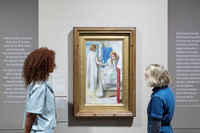
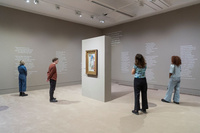
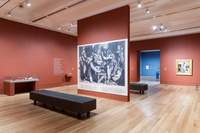
The various galleries of the exhibition take up a series of themes that relate to different aspects of the work of the Rossetti circle and are organized broadly chronologically. The warm, red-toned rooms require close looking at smaller-scale prints, drawings, and bound volumes in cases; these are interspersed with manuscripts, and some are enlarged in images placed on gallery walls (fig. 3). The second and third sections pick up familiar themes. For example, “Pre-Raphaelite Revolutionaries” juxtaposes William Holman Hunt’s (1827–1910) oil of Rienzi Vowing to Obtain Justice for the Death of his Young Brother, Slain in a Skirmish between the Colonna and the Orsini Factions (1848–49, retouched; Ramsbury Manor Foundation, Ramsbury) with Elizabeth Siddal’s ink on paper The Lady of Shalott (1853; The Maas Gallery, London) as well as portraits made by group members of each other. Lesser known aspects of the group are also introduced, such as Maria and Christina Rossetti’s involvement in the Anglican Church. Concerns for social justice and Victorian attitudes towards so-called “fallen” women are drawn out through poetry by Elizabeth Siddal and Christina Rossetti (who worked in a refuge for women), alongside Dante Gabriel Rossetti’s unfinished work Found (1854–55, 1859–81; Delaware Art Museum, Wilmington). A dividing wall is covered in an enlarged reproduction of Siddal’s Pippa Passes (1854; Ashmolean, Oxford), a piece that has been foregrounded in scholarship as indicative of Siddal’s interpretation of women occupying urban space.
The exhibition emphasizes the collaborative working methods of the Rossettis, most evident in the section “Medieval Moderns,” focusing on the shared studio of Dante Gabriel Rossetti and Elizabeth Siddal. Here we see detailed examinations of shared ideas through figures such as Siddal’s St. Cecilia (ca. 1854–55; National Trust, London), a subject and composition that Rossetti later took up. Siddal had hoped to contribute to an illustrated edition of Tennyson’s poems, known as the Moxon Tennyson (1857), where Dante Gabriel Rossetti’s adaptation of her design appeared alongside work by other Pre-Raphaelites. While many of Siddal’s drawings do not survive, they were photographed, and reproductions of these are visible on the walls alongside extant works. These include the well-known watercolor Lady Affixing Pennant to a Knight’s Spear (fig. 4), in which a vibrant red pennant draws the viewer into an intimate scene of departure.
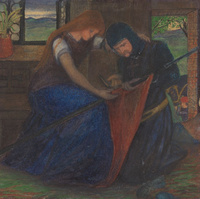
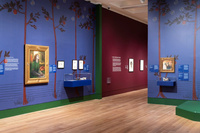
In a room entitled “The House of Life,” the exhibition’s warm red and grey tones give way to an arboreal, domestic space in bold blue (papered in a design by Dante Gabriel Rossetti and installed with furniture) (fig. 5). This room emphasizes the significance of domestic interiors, linking the lived experiences and unconventional households of Maria and Christina Rossetti (who remained single, living together, and working in a community of Anglican nuns), William Michael Rossetti (1829–1919), who married the artist and writer Lucy Madox Brown (1843–94), and Dante Gabriel Rossetti and Elizabeth Siddal, married for two years until her death in 1862. In addition, friendship and political networks are powerfully illustrated in the three pencil portraits from the same sitting in 1854 of Siddal with irises in her hair by artist-activists Anna Mary Howitt (1824-84), Barbara Leigh Smith Bodichon (1827-91) (both from the Mark Samuels Lasner Collection, Newark), and Dante Gabriel Rossetti (facsimile, National Gallery of Canada).
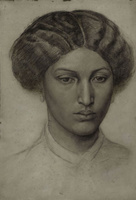
The final rooms shift quite dramatically to the later large oil paintings of female sitters for which Dante Gabriel Rossetti is so well-known, hung on burgundy walls. The first of these rooms, entitled “Venus Surrounded by Mirrors,” interrogates the orientalist fantasy of The Beloved (1863; Tate, London), with representations of working-class models from a range of cultures. One of the most reproduced works by Rossetti, The Beloved is a complicated work to discuss due to Rossetti’s racialized interpretation of female beauty in the biblical Song of Solomon.[1] Here studies of individual sitters surround the work in an attempt to give some record of the lived histories of models, impinged by racial and class hierarchies, including the Jamaican born Pre-Raphaelite model Fanny Eaton (1835–1924; fig. 6) and her daughter Fanny Matilda Eaton (1858-1939), as well as Keomi Gray Bonnett (1841–1914), a musician from a Roma family. Models wore textiles and jewelry, collected by Dante Gabriel Rossetti in London. An example represented in the painting is also displayed. A gold braided bracelet from Myanmar (ca. 1850; V&A Museum, London) given to Jane Morris by Dante Gabriel Rossetti similar to one worn by the central figure is exhibited in a vitrine.
Two additional rooms consider, first, the “Poetic Portraiture” of the 1860s, where models, including Fanny Cornforth and Alexa Wilding (1847–84), were often cast in mythical roles, and second, Dante Gabriel Rossetti’s “Obsession” with Jane Morris in the 1870s. High on a wall is a line from Dante Gabriel Rossetti’s sonnet “Body’s Beauty” (alternately titled “Lady Lilith”), “And round his heart one strangling golden hair” (1866); visitors can see the painted Lady Lilith (fig. 7) and, as in the first room in the exhibition, it is possible to step into a pool of sound to listen to a recording of the poem. The large-scale canvases around the walls, interspersed with sketches and drawings, include many representations of women who came to be associated with aestheticism or art for art’s sake (fig. 8). The second of these rooms considers Morris’s role as a maker in the Arts and Crafts movement as well as photographs that served Rossetti as references. Here one wall is covered with wallpaper based on Honeysuckle Embroidery, designed by Dante Gabriel Rossetti and embroidered by Jane Morris in 1880 (William Morris Gallery, London; figs. 9, 10). Later illustrated volumes and editions by Christina Rossetti, William Michael Rossetti, and Lucy Madox Brown feature in a glass case.[2]
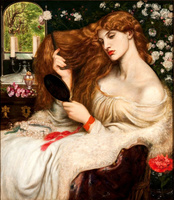
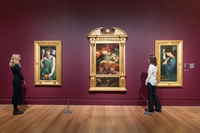
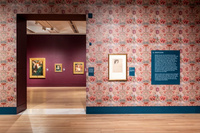
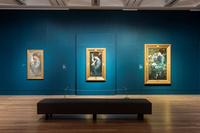
Finally, a room with hot pink walls entitled “Legacies” shifts briefly into the twentieth and twenty-first centuries, via suffrage and anarchist politics pursued by the children of Lucy Madox Brown and William Michael Rossetti, Helen (1879–1964) and Olivia Rossetti (1875–1960). The gallery includes a projection of Ken Russell’s film Dante’s Inferno as well as Sunil Gupta’s photographic Untitled #2 from the series The New Pre-Raphaelites (2008, printed 2021; Hales Gallery, New York), addressing LGBTQ+ rights in India.
The Tate’s 1984 Pre-Raphaelite exhibition was persuasively challenged in feminist scholarship.[3] Books and exhibitions dedicated to the Pre-Raphaelite sisterhood have continued to uncover new works and histories since the 1980s.[4] Four decades on, The Rossettis reframes Siddal as an artist (subverting the tendency to portray her solely as a muse for the Pre-Raphaelite Brotherhood, still current in popular culture) by bringing together many of her surviving works.
This is of course not the first attempt to address gender and class in Pre-Raphaelitism in a Tate blockbuster. For example, a decade ago the exhibition Pre-Raphaelites: Victorian Avant-Garde foregrounded Siddal’s work on the right wall of the first room, but it got somewhat lost in the larger exhibition.[5] More recently Pre-Raphaelite Sisters at the National Portrait Gallery (2019–20) focused on women associated with the movement as model, wife, artist, or muse.[6] The NPG exhibition pointed to the diverse contributions of women to the movement, including some of the women featured in The Rossettis (Elizabeth Siddal, Fanny Eaton, and Jane Morris). Convincing arguments evident in the show about women’s active participation in the movement as collaborators and producers were somewhat undermined by the gallery’s banner promotion of Morris as Rossetti’s muse. In response to Pre-Raphaelite Sisters, some critics asked for a more thorough interrogation of the sexist circumstances in which these artists worked, a move away from [Dante Gabriel] Rossetti-centric narratives, and a rich historical contextualization and formal analysis of work by the women artists—that is, the same sort of study and scholarship that has been lavished on male artists.[7]
The Rossettis can be seen as a visual and textual rejoinder. We see Siddal as an artist through an extensive display of her work, and the emphasis on writing highlights the parallel production of Christina Rossetti. Several of the works on display are from the Tate’s own substantial collection of Pre-Raphaelite paintings, watercolors, and drawings, as well as those of the partner institution, the Delaware Art Museum, but many of the works are drawn from other institutions and private collections.[8] Therefore, it presents a unique opportunity to see a wide-ranging selection of objects and think about working histories and relationships in a fresh light.
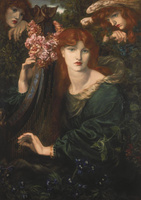
The curators decided to identify Siddal as Rossetti (due to her marriage), and this does relate to the premise of the exhibition; there were in fact Rossettis plural who were collaborators, and Elizabeth Siddal Rossetti differentiates this identity from her identity as “Lizzie” Siddal in popular culture. The use of Elizabeth Siddal Rossetti does risk Siddal’s identity being further subsumed into that of Dante Gabriel Rossetti. Emphasis on partnerships can be paradoxically encumbering, rather than emancipatory, for women artists. And the narrative about Dante Gabriel Rossetti’s dominance is difficult to efface in the final rooms, in part due to the sheer size of the oil paintings in comparison with the smaller works in ink, gouache, and watercolor in the earlier rooms. Jane Morris’s role as a maker is less present, although a collaborative relationship with William Morris (1834–96) is alluded to in the reproduction of her embroidery work as wallpaper.[9] It is Dante Gabriel Rossetti’s La Ghirlandata of 1873 that graces the marketing banners and room guide (fig. 11).
The catalogue does more to set the record straight on Siddal and offers close readings and interpretations of the objects and their historical contexts. It is a valuable source, richly illustrated and with numerous essays that give nuance and detail to the exhibition themes. Curators Carol Jacobi and James Finch lead with introductory essays on the Rossettis and their early family history. Dinah Roe examines Christina Rossetti as an activist, noting her social and class consciousness, and perplexing lack of support for voting rights for women. Elizabeth Prettejohn addresses the theme of revolutionaries and the Pre-Raphaelite Brotherhood, while Jan Marsh, the author of numerous publications on Pre-Raphaelite women, offers a “mythbusting” corrective on Elizabeth Siddal. Marsh shows that many myths about the artist are contradicted in records of Siddal’s independent lifestyle, physical wellbeing, and creativity.[10]
Jacobi discusses the social and political contexts for the infelicitously named “fallen” woman, a topic previously addressed in an exhibition at the Foundling Museum in 2015–16. The High Anglican sisterhoods, associated with Christina Rossetti, are seen in this social context of women who sold sex to men. These became visible in Siddal’s Pippa Passes as well as the work of other Pre-Raphaelites addressing modern life in London.
Glenda Youde sees Elizabeth Siddal and Dante Gabriel Rossetti as undertaking parallel projects related to medieval narration. She explores their partnership through a surviving photographic album and examples of their work portraying St. Cecilia. Gursiman Oberoi returns to the theme of model and muse for the sisterhood of artists, addressing the visit of Elizabeth Siddal to Barbara Bodichon in Hastings. Jacobi cites Dante Gabriel Rossetti’s sonnet sequence The House of Life (1881) in the context of unconventional households and new domestic interiors as exemplified by the furniture and bold wallpaper. Chiedza Mhondoro responds to The Beloved through a fictional account of the experience of the unknown boy in the foreground; Mhondoro follows the piece with an explication of her strategy for understanding the boy’s experiences of the racial and social hierarchies evinced in the production of the piece, noting for example that in Dante Gabriel Rossetti’s correspondence the word “jet,” normally used in relation to ornaments and jewelry, stands as a metaphor for the child.
Margaretta Frederick, Curator Emerita of the Bancroft Pre-Raphaelite Collection at the Delaware Art Museum, who initially collaborated with Jacobi on the exhibition, considers Dante Gabriel Rossetti’s depictions of modern beauty as troubling women exemplary of expanding female agency. Wendy Parkins looks to photographic portraits and paintings of Jane Morris to consider her literary interests, embroidery work on “eminent women” for Red House, and embodied skills as maker and embroiderer of the blue silk dress worn in Mrs. William Morris (The Blue Silk Dress) (1868; Kelmscott Manor, Kelmscott).[11]
Scholars have examined the historiography of Pre-Raphaelitism and the ways in which it has subsequently been interpreted through British visual and popular culture, often reiterating narratives centered on male members of the movement.[12] However, this pattern has shifted and a flurry of recent exhibitions and glossy publications focus attention on female participation and agency in Pre-Raphaelite art, poetry, dress, and design.[13] The exhibition coincides with the publication of substantive scholarship that is worth examining alongside the catalogue. Pre-Raphaelite Sisters: Art, Poetry and Female Agency in Victorian Britain, a collection of essays, engages with the 2019–20 Pre-Raphaelite Sisters exhibition by highlighting the multiplicity of women’s creative roles within the Pre-Raphaelite movement.[14] In addition, and in conjunction with The Rossettis exhibition, Jan Marsh, the author of numerous related books and catalogues, has published Elizabeth Siddal: Her Story, bypassing the myth to present Elizabeth Siddal as an independent woman who attended art school in Sheffield.[15] In sum, The Rossettis exhibition presents a compelling way of reading the Pre-Raphaelites through a collaborative lens, demonstrating that creativity and independence were not resolutely male. However, the competing narratives evident across the galleries underline the challenges of displaying the Rossettis alongside one another.
Notes
[1] The Race, Empire and Pre-Raphaelites British Art Research Group has recently prepared a digital resource for museum and higher education practitioners on engaging with complex and difficult histories. “Digital-Museum-Resource-1.Pdf,” accessed December 15, 2023, https://britishartnetwork.org.uk/.
[2] The latter artist was the subject of an exhibition co-curated by Ruth Brimacombe at the Watts Gallery titled “Uncommon Power”: Catherine and Lucy Madox Brown (2021–22); Angela Thirlwell, William and Lucy: The Other Rossettis (New Haven: Yale University Press, 2003). See recent publications on other women artists associated with the movement; for example, Susan Miller Bradbury ed., The Boyce Papers: The Letters and Diaries of Joanna Boyce, Henry Wells and George Price Boyce (Woodbridge, Suffolk: The Boydell Press, 2019); Margaretta S. Frederick et al., Evelyn & William De Morgan: A Marriage of Arts & Crafts (New Haven: Yale University Press, 2022).
[3] Alan Bowness and Leslie Parris, The Pre-Raphaelites, exh. cat. (London: Tate Gallery, 1984). Deborah Cherry and Griselda Pollock published their groundbreaking article on the representation of Elizabeth Siddal, “Woman as Sign in Pre-Raphaelite Literature: A Study of the Representation of Elizabeth Siddall,” Art History 7, no. 2 (1984): 206–27, https://doi.org/10.1111/j.1467-8365.1984.tb00141.x. Warmest thanks to Deborah Cherry for her generous and thoughtful discussion.
[4] On the Pre-Raphaelite Sisterhood see Jan Marsh, Pre-Raphaelite Sisterhood (London: Quartet, 1985); Jan Marsh, Elizabeth Siddal: Pre-Raphaelite Artist, 1829–1862, exh. cat. (Sheffield: Ruskin Gallery, 1991); Jan Marsh and Pamela Gerrish Nunn, Women Artists and the Pre-Raphaelite Movement (London: Virago, 1989); Jan Marsh and Pamela Gerrish Nunn, Pre-Raphaelite Women Artists, exh. cat. (Manchester: The Galleries, 1997).
[5] T. J. Barringer, Jason Rosenfeld, and Alison Smith, Pre-Raphaelites: Victorian Avant Garde, exh. cat. (London: Tate, 2012).
[6] Jan Marsh et al., Pre-Raphaelite Sisters (London: National Portrait Gallery Publications, 2019).
[7] Mariëlle Ekkelenkamp, “Exhibition Review of Pre-Raphaelite Sisters,” Nineteenth-Century Art Worldwide 19, no. 1 (2020), https://doi.org/10.29411/ncaw.2020.19.1.13; Amelia Yeates, “Review of ‘Pre-Raphaelite Sisters’ at the National Portrait Gallery, London,” 19: Interdisciplinary Studies in the Long Nineteenth Century, no. 30 (August 5, 2020), https://doi.org/10.16995/ntn.2946. Many thanks to my MA group for their lively and questioning seminars, and to colleagues in the British Women Artists network.
[8] On the extraordinary Delaware Art Museum collection see Tara Contractor, “Installation Review of British Pre-Raphaelite Collection, Delaware Art Museum, Wilmington,” Nineteenth-Century Art Worldwide 21, no. 3 (Autumn 2022), https://doi.org/10.29411/ncaw.2022.21.3.8.
[9] The Tate’s 2012 Pre-Raphaelite exhibition included embroideries made by Jane and May Morris (bed, Kelmscott Manor) and the NPG’s Pre-Raphaelite Sisters included two exquisite examples, a pair of shoes embroidered by Marie Spartali Stillman (Delaware Art Museum) and a purse thought to be designed and embroidered by Jane Morris (Victoria and Albert Museum). Collaborative households and design are also taken up in the new volume by Suzanne Fagence Cooper, How We Might Live: At Home with Jane and William Morris (London: Quercus Editions Ltd., 2022).
[10] See also recent publications on Siddal’s writing, such as Deborah Cherry, “Three Books about Elizabeth Siddall’s Poetry,” Nineteenth-Century Art Worldwide 20, no. 3 (Autumn 2021), https://doi.org/10.29411/ncaw.2021.20.3.11.
[11] See also Johanna Amos’s foregrounding of Jane Morris’s agency as an embroiderer in self-fashioning, observing that for Morris “needlework intersected with the growth of personal and professional relationships, involving the exchange of knowledge, materials, designs, and techniques, as well as shared labor and invention.” Johanna Amos, “‘Experiments in Silk and Gold Work Afterwards to Bloom’: The Embroidering of Jane Burden Morris,” in Stitching the Self: Identity and the Needle Arts, ed. Lisa Binkley and Johanna Amos (London: Bloomsbury Visual Arts, 2020), 45.
[12] T. J. Barringer and Michaela Giebelhausen, eds., Writing the Pre-Raphaelites: Text, Context, Subtext (Farnham: Ashgate, 2009); Chloe Johnson, “Presenting the Pre-Raphaelites: From Radio Reminiscences to Desperate Romantics,” Visual Culture in Britain 11, no. 1 (February 10, 2010): 67–92, https://doi.org/10.1080/14714780903509847.
[13] In this context the foundational nature of Marsh’s work must be acknowledged (see above note 4).
[14] Glenda Youde and Robert Wilkes, Pre-Raphaelite Sisters: Art, Poetry and Female Agency in Victorian Britain, vol. 49, Cultural Interactions: Studies in the Relationship between the Arts (Oxford: Peter Lang, 2022). As well as essays on Siddal, Christina Rossetti, Fanny Eaton, Jane Morris, and Barbara Bodichon, a number of essays contribute new research on individuals not featured in the Rossettis, such as Evelyn De Morgan and Eleanor Fortescue-Brickdale.
[15] Jan Marsh, Elizabeth Siddal: Her Story (London: Pallas Athene, 2023).